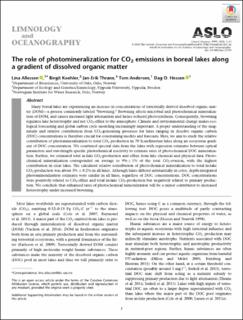| dc.contributor.author | Allesson, Lina | |
| dc.contributor.author | Koehler, Birgit | |
| dc.contributor.author | Thrane, Jan-Erik | |
| dc.contributor.author | Andersen, Tom | |
| dc.contributor.author | Hessen, Dag O | |
| dc.date.accessioned | 2020-10-27T15:04:36Z | |
| dc.date.available | 2020-10-27T15:04:36Z | |
| dc.date.created | 2020-10-15T13:34:33Z | |
| dc.date.issued | 2020 | |
| dc.identifier.citation | Limnology and Oceanography. 2020. | en_US |
| dc.identifier.issn | 0024-3590 | |
| dc.identifier.uri | https://hdl.handle.net/11250/2685352 | |
| dc.description.abstract | Many boreal lakes are experiencing an increase in concentrations of terrestrially derived dissolved organic matter (DOM)—a process commonly labeled “browning.” Browning affects microbial and photochemical mineralization of DOM, and causes increased light attenuation and hence reduced photosynthesis. Consequently, browning regulates lake heterotrophy and net CO2‐efflux to the atmosphere. Climate and environmental change makes ecological forecasting and global carbon cycle modeling increasingly important. A proper understanding of the magnitude and relative contribution from CO2‐generating processes for lakes ranging in dissolve organic carbon (DOC) concentrations is therefore crucial for constraining models and forecasts. Here, we aim to study the relative contribution of photomineralization to total CO2 production in 70 Scandinavian lakes along an ecosystem gradient of DOC concentration. We combined spectral data from the lakes with regression estimates between optical parameters and wavelength specific photochemical reactivity to estimate rates of photochemical DOC mineralization. Further, we estimated total in‐lake CO2‐production and efflux from lake chemical and physical data. Photochemical mineralization corresponded on average to 9% ± 1% of the total CO2‐evasion, with the highest contribution in clear lakes. The calculated relative contribution of photochemical mineralization to total in‐lake CO2‐production was about 3% ± 0.2% in all lakes. Although lakes differed substantially in color, depth‐integrated photomineralization estimates were similar in all lakes, regardless of DOC concentrations. DOC concentrations were positively related to CO2‐efflux and total in‐lake CO2‐production but negatively related to primary production. We conclude that enhanced rates of photochemical mineralization will be a minor contributor to increased heterotrophy under increased browning. | en_US |
| dc.language.iso | eng | en_US |
| dc.publisher | ASLO | en_US |
| dc.rights | Navngivelse 4.0 Internasjonal | * |
| dc.rights.uri | http://creativecommons.org/licenses/by/4.0/deed.no | * |
| dc.title | The role of photomineralization for CO2 emissions in boreal lakes along a gradient of dissolved organic matter | en_US |
| dc.type | Peer reviewed | en_US |
| dc.type | Journal article | en_US |
| dc.description.version | publishedVersion | en_US |
| dc.rights.holder | © 2020 The Authors | en_US |
| dc.source.pagenumber | 13 | en_US |
| dc.source.journal | Limnology and Oceanography | en_US |
| dc.identifier.doi | 10.1002/lno.11594 | |
| dc.identifier.cristin | 1839836 | |
| dc.relation.project | Norges forskningsråd: 196336 | en_US |
| dc.relation.project | Norges forskningsråd: 224779 | en_US |
| cristin.ispublished | true | |
| cristin.fulltext | original | |
| cristin.qualitycode | 1 | |

